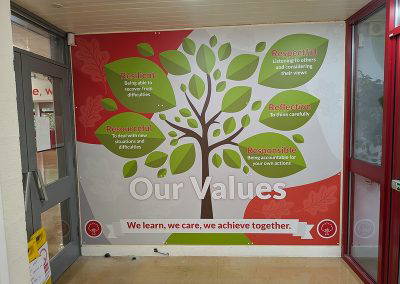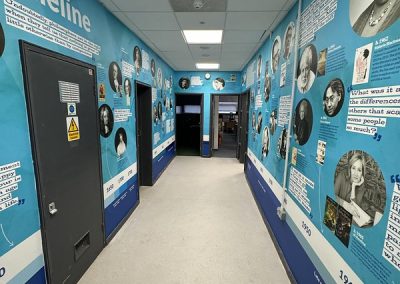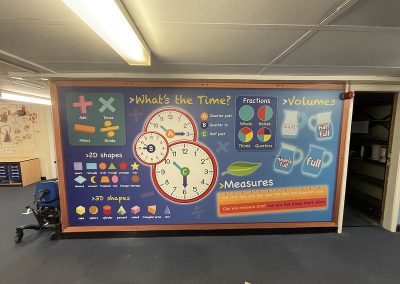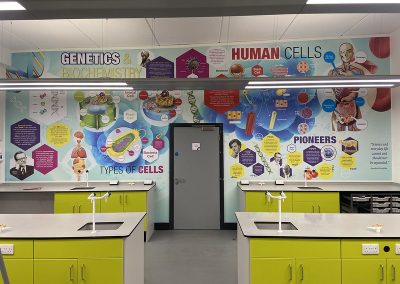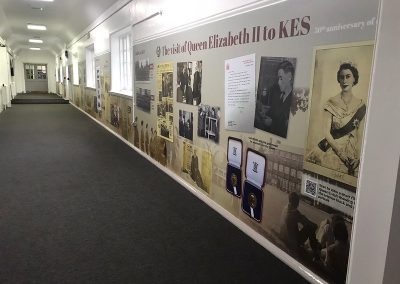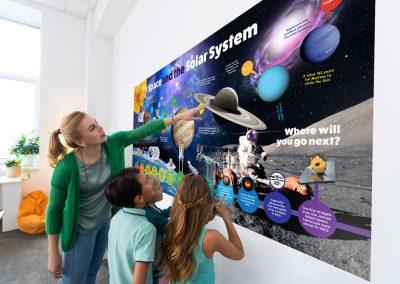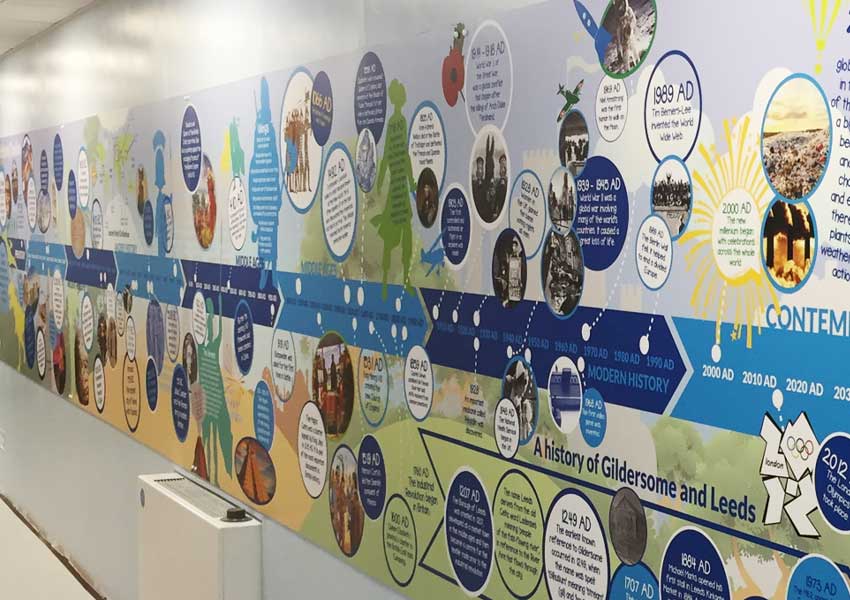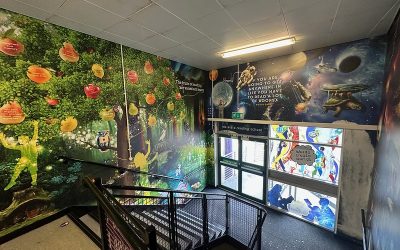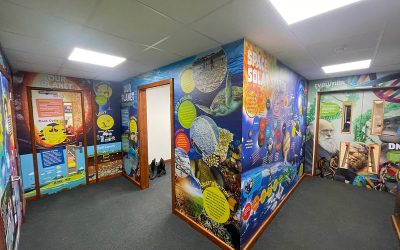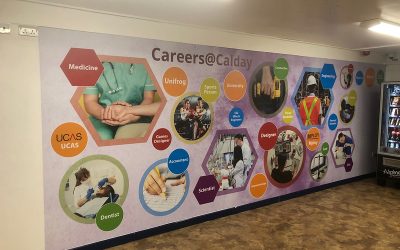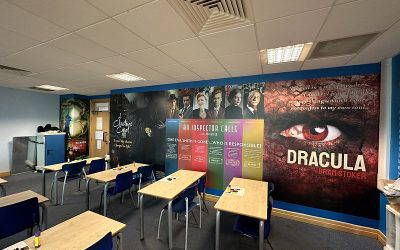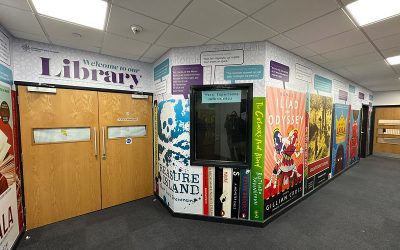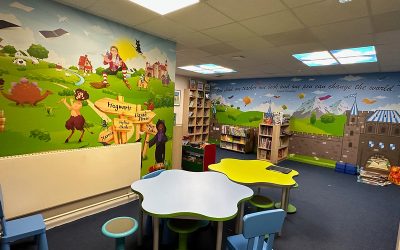Transforming Classroom Walls into Educational Tools
Interactive learning through school walls is a strategy being employed by some of the most innovative and high-performing schools in the UK. When you consider that researchers have discovered that 80% of classroom learning is visual, the advantages of installing learning walls in schools become clear.
Indeed, school walls can be transformed into powerful tools for interactive learning, transforming otherwise bland and boring spaces into landscapes that inspire and engage students with meaningful learning experiences.
Is your school overlooking the potential of its space? In this article, we explore actionable design tips for turning ordinary school walls into dynamic learning spaces. From blending technology with creative design to catering to various learning styles, we’ll show you how every step along the corridors of your school can be utilised to positively impact your pupils’ learning environment.
What Is Interactive Learning, and Why Does It Matter in Education?
When we hear the term ‘interactive learning’, many educators immediately consider technology. However, it’s much more than this. It’s about creating an environment that inspires students to become actively engaged in their learning.
Interactive learning through school walls works because it delivers information passively, and then encourages students to discuss and question, as well as interact with the curriculum, school materials, peers, and teaching staff. What is, essentially, a vast visual aid evolves into a multisensory educational experience.
In this regard, your school walls provide an incredible and unique canvas to boost interactive learning. By incorporating elements such as dynamic visuals, tactile elements, and even auditory cues, school walls and interactive classroom displays become much more than decorative displays – they become integral educational tools, helping to inspire engagement as students enter a classroom, and reinforce learning when leaving.
Well-designed school wall displays that incorporate school interactive whiteboards and other innovations encourage creativity, critical thinking, and collaboration, helping to prepare students for modern life beyond the classroom.
Why Focus on School Walls?
School walls are large, prominent, and accessible to every student. Whether in hallways, classrooms, or communal areas, your school’s walls offer vast, underutilised space that is ideal to catch the eye and spark curiosity. In addition, this wall space provides:
· Opportunities for Collaborative and Individual Learning
Interactive walls are perfect spaces to inspire group projects, brainstorming sessions, and independent exploration. As an idea of the power of incorporating interactive classroom display ideas into your school murals, Birchfield Primary School developed a history timeline that spans our planet’s story from dinosaurs to modern-day events, focusing on local history to bring an extra level of relevance. Such a timeline can encourage students to contribute their thoughts and ideas, not only engaging them in the subject but also building a sense of community.
· Reinforcement of Curriculum and School Values
Your school wall displays can also support and promote your core values and school ethos. Located near its reception area, this is exactly what the wall art at St John the Baptist School achieves. Through a combination of quotes and eye-catching visuals, as well as thoughtful use of colour and design, such a display enhances a school’s branding and helps to create a real sense of identity.
· Opportunities for Integration of Technology
Incorporating tools like school interactive whiteboards, QR codes, and augmented reality (AR), traditional wall displays can deliver an experience that is both educational and fun.
How Can You Design Interactive Walls That Inspire?
When designing school wall displays to include interactive elements, we have found there are five key factors to consider:
1. The Integration of Dynamic Content
Interactive learning through school walls must have a solid foundation, yet simultaneously should not feel static. It’s crucial to keep the content fresh and relevant by using:
- Visually impactful designs such as timelines, infographics, and themed displays that mirror the curriculum. For example, school murals can be used to ignite curiosity and learning. Our Space and Solar System Wall Display is designed to do exactly this, as well as conform to the elements of the national curriculum programmes of study for key stages 1 and 2.
- Dynamic content like pinboards, interactive whiteboards, and magnetic surfaces for rotating content.
- Hybrid designs, such as combining digital and analogue features, or embedding a touchscreen alongside physical manipulatives.
2. How to Utilise Technology
Technology delivers exciting possibilities for interactive walls:
- School interactive whiteboards bring lessons to life with videos, simulations, and collaborative tools.
- QR codes and AR enable immersive learning. For example, a QR code on a history wall might link to a virtual tour of an ancient site, or AR could turn a wall into an interactive educational ecosystem.
3. Catering to Multiple Learning Styles
Effective designs cater to the diverse needs of students, by incorporating:
- Visual aids like charts, diagrams, and colour-coded maps, which are essential for visual learners.
- Tactile elements like puzzles, movable parts, or textured surfaces to engage kinaesthetic learners.
- Auditory tools, such as sound buttons or built-in speakers, which can bring a storytelling corner to life for auditory learners.
4. How to Promote Collaboration
Interactive walls can encourage teamwork and problem-solving. Well-designed wall displays can be integrated with:
- Group brainstorming areas, like writable walls or sticky-note boards, which invite students to work together.
- Shared projects areas such as class art displays or collective question boards, to foster a sense of ownership and pride in shared achievements.
5. How to Support Individual Exploration
Not all students thrive in group settings. Interactive walls can also encourage individual learning by:
- Providing self-paced activities, like skill-building puzzles or individual goal trackers.
- Incorporating personal milestones, such as progress charts, to celebrate achievements and inspire motivation.
What Challenges Might You Face, and How Can You Overcome Them?
When designing interactive walls, it’s crucial to avoid ‘overcrowding’. Trying to incorporate too much information or technological elements into restricted spaces can overwhelm students. Therefore, designs should be focused, clean, and presented with clarity. Organising information into distinct sections or zones ensures that your displays are visually appealing, easy to navigate, and relevant.
You’ll also need to consider durability and maintenance, especially in high-traffic areas where students brush against walls and in areas that are subjected to the weather. We always use materials that are wipeable, child-friendly, and created using materials that can withstand the rigors of daily use in a school environment.
Finally, we understand that all schools have budget constraints, which is why we discuss options at length, homing in on priorities, streamlining design and implementation, and working within your specific financial budget.
Investment in the Environment Is an Investment in Education
By blending creativity and technology interactive learning through school wall art can inspire curiosity, enhance collaboration, and cater to every learning style.
At Design for Education, we specialise in creating vibrant, effective, and durable school wall designs that bring learning to life. Whether you’re looking to implement a learning wall, a school interactive whiteboard display, or an entire suite of interactive classroom display ideas, we’re here to help.
Together, we can transform your wall space into an imaginative environment that teaches, inspires, and engages your students. Contact us today to discover how.
More like this…
School Wall Displays: Engaging Students Beyond the Classroom
Unlock the Hidden Power of Your Educational Environment School wall displays are a powerful yet often underutilised tool in education. The power of well-designed, vibrant school wall murals goes far beyond improving the aesthetics of a school. They become an extension...
School Walls as Learning Tools: Engaging Displays for Every Subject
Reimagining School Walls for Dynamic Education In the modern education environment, using school walls as learning tools helps teaching staff to go beyond textbooks and digital screens. Indeed, they are proving to be an integral visual learning tool, with research...
How School Wall Displays Inspire Your Students
The walls of a classroom do more than just enclose a space, they also shape your students learning environment. Thoughtfully designed school wall displays can ignite curiosity, celebrate achievements, and reinforce key concepts, making learning more engaging. Whether showcasing student work, visualising complex ideas, or creating an inspiring atmosphere, well-crafted displays encourage participation as well as motivation. The right visuals can transform your classroom into a dynamic, stimulating space that supports both academic success and personal growth.
Transforming School Walls: Inspiring Educational Spaces with Custom Wall Art
Transforming school walls with custom wall art can create inspiring educational spaces that foster creativity, motivation, and engagement among students. By incorporating vibrant designs that reflect a school’s values and curriculum, such as historical timelines or scientific concepts, educators can enhance learning environments and reinforce school identity. Thoughtfully designed wall art not only creates engaging spaces but also serves as an educational tool, turning blank walls into sources of inspiration.
Using Wall Art in School Libraries to Foster a Love for Reading
Creating Dynamic Reading Spaces with Murals and Interactive Displays Employing wall art in your school library is a wonderful way to create a vibrant, inviting atmosphere that encourages students to read more. From literary-themed murals to interactive graphics,...
10 Creative Wall Art Ideas for Primary Schools
Looking to brighten up your primary school’s walls? Our team have assembled 10 creative wall art ideas for primary schools which can transform dull spaces into vibrant, educational canvases. From murals that promote core values and inspire growth mindsets to interactive literacy and numeracy walls, these designs bring learning to life. Celebrate diversity, showcase history, or create themed learning corners – each idea fosters a welcoming environment and supports students’ development. Whether indoors or outdoors, school wall art is a powerful tool to reflect your school’s ethos, enhance engagement, and inspire creativity.
Creating an Effective Wall Art Brief for Your School
Creating a wall art brief for your school is essential for reflecting growth, evolving visions, or modernising an outdated identity. This process involves aligning the school’s overarching goals with a cohesive visual narrative that enhances the learning environment and embodies the school’s unique qualities. Our article outlines the major challenges and provides expert guidance to create a compelling wall art brief, ensuring that the design aligns with your school’s identity and vision.
Sure-Fire Strategies to Improve Mental Health in Schools
Helping Teachers to Prioritise Children’s Mental Health Effectively Mental health in schools is a real and growing concern for teachers in the UK. Children’s mental health and wellbeing was heavily impacted upon during the pandemic. Whilst many children returned to...

